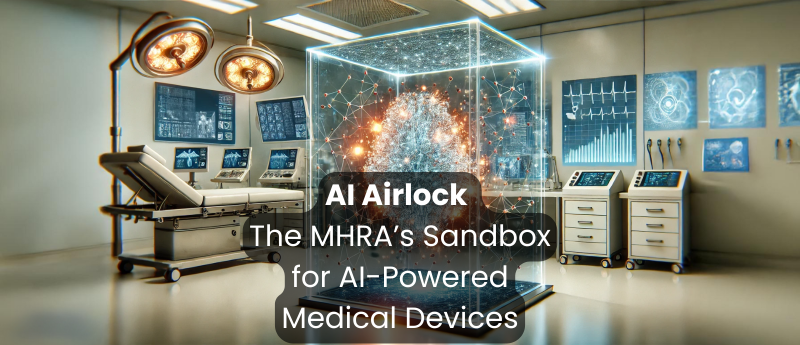AI Airlock | The MHRA’s Sandbox for AI-Powered Medical Devices

The MHRA’s AI Airlock initiative introduces a “sandbox” approach to test AI-powered medical devices in a controlled research environment, ensuring innovation meets safety standards. It has selected five tools for assessment in a pilot programme.
The impact of AI based innovation on the medical field is rapidly expanding, providing new tools and opportunities to facilitate improved healthcare across the globe. Though this introduces exciting new possibilities for patients and healthcare workers, it is critical to ensure that these programmes and devices are safe and effective before being used on real patients. Unfortunately, the novelty and complexity of such technology can make regulation extremely difficult, often delaying and limiting the benefit that it could deliver.
In order to meet this challenge, the Medicines and Healthcare products Regulatory Agency (MHRA) designed the AI Airlock programme, first announced in Spring 2024. This is a “sandbox” i.e. a controlled, simulated environment where devices and software can be tested and observed by the most appropriate subject matter experts, in order to assess safety and gather data.
The MHRA announced that the AI Airlock pilot scheme will involve partnership with the NHS AI lab, the Department of Health and Social Care and Team AB (an established group of “Approved Bodies”). In addition, they will be collaborating with a wide range of relevant experts from research to government, with input from the Information Commissioner’s Office along with other key regulators.
Applications to join AI Airlock closed in Spring, and the first five participants of the pilot scheme were subsequently announced:
Software designed to analyse data from patients with conditions such as chronic obstructive pulmonary disorder, in order to predict future treatment needs, decrease the frequency of unplanned hospital admissions and improve long-term outcomes3
2. Philips Radiology Reporting
A programme aiming to integrate AI into the reporting of scan results, whereby the software produces a concise summary of a detailed radiology report for the referring doctor. This summary is usually written by the radiologist and automation could potentially increase efficiency, ease workload, and minimise error.
3. FAMOS (Federated AI Monitoring Service)
A component of the Newton’s Tree platform designed to monitor and regulate other AI software operating in a medical setting. If successful, FAMOS would be able to identify issues such as “drift” (where AI performance declines over time, often due to variation in the data input such as new patients or equipment). Fixing such problems as they arise would improve safety and accuracy.
As well as this, the hardware required for FAMOS is able to be delivered and set-up within the healthcare building, ensuring sensitive and confidential patient data can be screened locally instead of being sent to a central server.
4. OncoFlow
AI software that can help medical professionals design individualised management plans for oncology patients. Choosing the correct oncological treatment can be difficult and time consuming due to the complexity of both the disease and the therapies available. Such technology could help patients receive effective treatment faster, potentially improving their prognoses. Thus far, OncoFlow has been focussed on breast cancer care, but with a plan to eventually adapt the same technology to different types of cancer.
An AI device developed by Automedica that enables healthcare workers to “smart search” for medical research and guidelines. It uses a Retrieval-Augmented Generation (RAG) framework to combine a large language model (LLM) with a database of verified resources such as the National Institute of Health and Care Excellence. The integration of only specific, trusted sources for the LLM to search through minimises the risk of AI using erroneous information from the internet to generate inaccurate results.
Staff using SmartGuideline could theoretically input a clinical question and instantly receive a validated and up-to-date answer from a curated source. This would reduce error and save time that would otherwise be spent sifting through large amounts of information for useful guidance.
Looking Ahead
The MHRA noted that being chosen for AI Airlock did not guarantee regulatory approval, however the data from the pilot scheme will likely impact medical device regulation going forward in the UK.
In a press release, MHRA Chief officer Laura Squire stated, “By examining the technologies announced (above) in a safe setting, in partnership with technology specialists, developers and the NHS, we can test and improve the rules for AI-powered medical devices, helping get products like these to the hospitals and patients who need them sooner.”
The AI Airlock initiative represents more than a regulatory step—it’s a blueprint for integrating cutting-edge innovation into healthcare responsibly. By fostering collaboration and rigorous testing, the MHRA is setting a precedent for how safety and innovation can coexist, potentially accelerating global adoption of transformative technologies.
Beyond improving regulatory processes, the programme raises broader questions about the future of healthcare. Could sandbox models become the standard for fast-tracking advancements while ensuring safety? As the pilot progresses, its impact may extend far beyond the UK, reshaping healthcare systems and redefining how we bridge the gap between innovation and regulation.
The AI Airlock pilot phase is expected to conclude in Spring 2025.